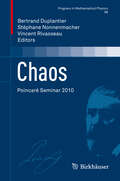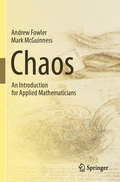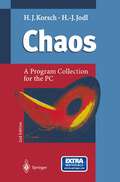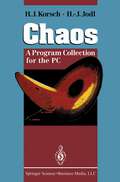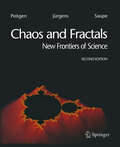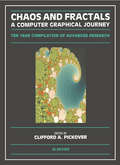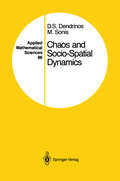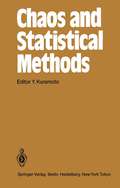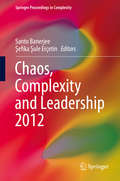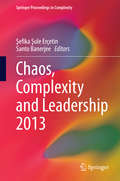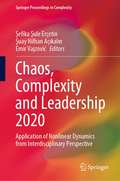- Table View
- List View
Chaos: Poincaré Seminar 2010 (Progress in Mathematical Physics #66)
by Bertrand Duplantier Stéphane Nonnenmacher Vincent RivasseauThis twelfth volume in the Poincaré Seminar Series presents a complete and interdisciplinary perspective on the concept of Chaos, both in classical mechanics in its deterministic version, and in quantum mechanics. This book expounds some of the most wide ranging questions in science, from uncovering the fingerprints of classical chaotic dynamics in quantum systems, to predicting the fate of our own planetary system. Its seven articles are also highly pedagogical, as befits their origin in lectures to a broad scientific audience. Highlights include a complete description by the mathematician É. Ghys of the paradigmatic Lorenz attractor, and of the famed Lorenz butterfly effect as it is understood today, illuminating the fundamental mathematical issues at play with deterministic chaos; a detailed account by the experimentalist S. Fauve of the masterpiece experiment, the von Kármán Sodium or VKS experiment, which established in 2007 the spontaneous generation of a magnetic field in a strongly turbulent flow, including its reversal, a model of Earth’s magnetic field; a simple toy model by the theorist U. Smilansky – the discrete Laplacian on finite d-regular expander graphs – which allows one to grasp the essential ingredients of quantum chaos, including its fundamental link to random matrix theory; a review by the mathematical physicists P. Bourgade and J.P. Keating, which illuminates the fascinating connection between the distribution of zeros of the Riemann ζ-function and the statistics of eigenvalues of random unitary matrices, which could ultimately provide a spectral interpretation for the zeros of the ζ-function, thus a proof of the celebrated Riemann Hypothesis itself; an article by a pioneer of experimental quantum chaos, H-J. Stöckmann, who shows in detail how experiments on the propagation of microwaves in 2D or 3D chaotic cavities beautifully verify theoretical predictions; a thorough presentation by the mathematical physicist S. Nonnenmacher of the “anatomy” of the eigenmodes of quantized chaotic systems, namely of their macroscopic localization properties, as ruled by the Quantum Ergodic theorem, and of the deep mathematical challenge posed by their fluctuations at the microscopic scale; a review, both historical and scientific, by the astronomer J. Laskar on the stability, hence the fate, of the chaotic Solar planetary system we live in, a subject where he made groundbreaking contributions, including the probabilistic estimate of possible planetary collisions. This book should be of broad general interest to both physicists and mathematicians.
Chaos: An Introduction for Applied Mathematicians
by Andrew Fowler Mark McGuinnessThis is a textbook on chaos and nonlinear dynamics, written by applied mathematicians for applied mathematicians. It aims to tread a middle ground between the mathematician's rigour and the physicist’s pragmatism.While the subject matter is now classical and can be found in many other books, what distinguishes this book is its philosophical approach, its breadth, its conciseness, and its exploration of intellectual byways, as well as its liberal and informative use of illustration. Written at the graduate student level, the book occasionally drifts from classical material to explore new avenues of thought, sometimes in the exercises. A key feature of the book is its holistic approach, encompassing the development of the subject since the time of Poincaré, and including detailed material on maps, homoclinic bifurcations, Hamiltonian systems, as well as more eclectic items such as Julia and Mandelbrot sets. Some of the more involved codes to produce the figures are described in the appendix.Based on lectures to upper undergraduates and beginning graduate students, this textbook is ideally suited for courses at this level and each chapter includes a set of exercises of varying levels of difficulty.
Chaos: A Program Collection for the PC
by Hans Jürgen Korsch Hans-Jörg JodlChaos: A Program Collection for the PC presents an outstanding selection of executable programs with introductory texts to chaos theory and its simulation. Students in physics, mathematics, and engineering will find a thorough introduction to fundamentals and applications in this field. Many numerical experiments and suggestions for further studies help the reader to become familiar with this fascinating topic. The second edition includes one CD-ROM, the executable programs are Windows 95 compatible.
Chaos: A Program Collection for the PC
by Hans Jürgen Korsch Hans-Jörg Jodl Timo HartmannThis new edition strives yet again to provide readers with a working knowledge of chaos theory and dynamical systems. It does so through parallel introductory explanations in the book and interaction with carefully-selected programs supplied on the accompanying disk. The programs enable readers, especially advanced-undergraduate students in physics, engineering, and math, to tackle relevant physical systems quickly on their PCs, without distraction from algorithmic details. For the third edition of Chaos: A Program Collection for the PC, each of the previous twelve programs is polished and rewritten in C++ (both Windows and Linux versions are included). A new program treats kicked systems, an important class of two-dimensional problems.
Chaos: A Program Collection for the PC
by H.J. Korsch H.-J. JodlAn outstanding selection of executable programs with introductory texts to chaos theory and its simulation. Students in physics, mathematics, and engineering will find a thorough introduction to fundamentals and applications in this field, backed by many numerical experiments and suggestions for further studies.Ten executable programs and numerous examples are included on two 3 1/2" MS-DOS diskettes.
Chaos: The World of Nonperiodic Oscillations (Understanding Complex Systems #Vol. 84)
by Otto E. Rössler Christophe LetellierWritten in the 1980s by one of the fathers of chaos theory, Otto E. Rössler, the manuscript presented in this volume eventually never got published. Almost 40 years later, it remains astonishingly at the forefront of knowledge about chaos theory and many of the examples discussed have never been published elsewhere. The manuscript has now been edited by Christophe Letellier - involved in chaos theory for almost three decades himself, as well as being active in the history of sciences - with a minimum of changes to the original text.Finally released for the benefit of specialists and non-specialists alike, this book is equally interesting from the historical and the scientific points of view: an unconventionally modern approach to chaos theory, it can be read as a classic introduction and short monograph as well as a collection of original insights into advanced topics from this field.
Chaos: From Theory to Applications
by A.A. TsonisBased on chaos theory two very important points are clear: (I) random looking aperiodic behavior may be the product of determinism, and (2) nonlinear problems should be treated as nonlinear problems and not as simplified linear problems. The theoretical aspects ofchaos have been presented in great detail in several excellent books published in the last five years or so. However, while the problems associated with applications of the theory-such as dimension and Lyapunov exponentsestimation, chaosand nonlinear pre diction, and noise reduction-have been discussed in workshops and ar ticles, they have not been presented in book form. This book has been prepared to fill this gap between theory and ap plicationsand to assist studentsand scientists wishingto apply ideas from the theory ofnonlinear dynamical systems to problems from their areas of interest. The book is intended to be used as a text for an upper-level undergraduate or graduate-level course, as well as a reference source for researchers. My philosophy behind writing this book was to keep it simple and informative without compromising accuracy. I have made an effort to presentthe conceptsby usingsimplesystemsand step-by-stepderivations. Anyone with an understanding ofbasic differential equations and matrix theory should follow the text without difficulty. The book was designed to be self-contained. When applicable, examples accompany the theory. The reader will notice, however, that in the later chapters specific examples become less frequent. This is purposely done in the hope that individuals will draw on their own ideas and research projects for examples.
Chaos and Complex Systems: Proceedings of the 5th International Interdisciplinary Chaos Symposium (Springer Proceedings in Complexity)
by Stavros G. Stavrinides Mehmet OzerThis book presents the proceedings of the “5th International Interdisciplinary Chaos Symposium on Chaos and Complex Systems (CCS).” All Symposia in the series bring together scientists, engineers, economists and social scientists, creating a vivid forum for discussions on the latest insights and findings obtained in the areas of complexity, nonlinear dynamics and chaos theory, as well as their interdisciplinary applications. The scope of the latest Symposium was enriched with a variety of contemporary, interdisciplinary topics, including but not limited to: fundamental theory of nonlinear dynamics, networks, circuits, systems, biology, evolution and ecology, fractals and pattern formation, nonlinear time series analysis, neural networks, sociophysics and econophysics, complexity management and global systems.
Chaos and Complex Systems: Proceedings of the 4th International Interdisciplinary Chaos Symposium
by Stavros G. Stavrinides, Santo Banerjee, Suleyman Hikmet Caglar and Mehmet OzerComplexity Science and Chaos Theory are fascinating areas of scientific research with wide-ranging applications. The interdisciplinary nature and ubiquity of complexity and chaos are features that provides scientists with a motivation to pursue general theoretical tools and frameworks. Complex systems give rise to emergent behaviors, which in turn produce novel and interesting phenomena in science, engineering, as well as in the socio-economic sciences. The aim of all Symposia on Chaos and Complex Systems (CCS) is to bring together scientists, engineers, economists and social scientists, and to discuss the latest insights and results obtained in the area of corresponding nonlinear-system complex (chaotic) behavior. Especially for the “4th International Interdisciplinary Chaos Symposium on Chaos and Complex Systems,” which took place April 29th to May 2nd, 2012 in Antalya, Turkey, the scope of the symposium had been further enlarged so as to encompass the presentation of work from circuits to econophysics, and from nonlinear analysis to the history of chaos theory. The corresponding proceedings collected in this volume address a broad spectrum of contemporary topics, including but not limited to networks, circuits, systems, biology, evolution and ecology, nonlinear dynamics and pattern formation, as well as neural, psychological, psycho-social, socio-economic, management complexity and global systems.
Chaos and Dynamical Systems: Lessons For Complex Systems (Primers in Complex Systems #14)
by David FeldmanChaos and Dynamical Systems presents an accessible, clear introduction to dynamical systems and chaos theory, important and exciting areas that have shaped many scientific fields. While the rules governing dynamical systems are well-specified and simple, the behavior of many dynamical systems is remarkably complex. Of particular note, simple deterministic dynamical systems produce output that appears random and for which long-term prediction is impossible. Using little math beyond basic algebra, David Feldman gives readers a grounded, concrete, and concise overview.In initial chapters, Feldman introduces iterated functions and differential equations. He then surveys the key concepts and results to emerge from dynamical systems: chaos and the butterfly effect, deterministic randomness, bifurcations, universality, phase space, and strange attractors. Throughout, Feldman examines possible scientific implications of these phenomena for the study of complex systems, highlighting the relationships between simplicity and complexity, order and disorder.Filling the gap between popular accounts of dynamical systems and chaos and textbooks aimed at physicists and mathematicians, Chaos and Dynamical Systems will be highly useful not only to students at the undergraduate and advanced levels, but also to researchers in the natural, social, and biological sciences.
Chaos and Fractals: New Frontiers of Science
by Heinz-Otto Peitgen Hartmut Jürgens Dietmar SaupeFor almost ten years chaos and fractals have been enveloping many areas of mathematics and the natural sciences in their power, creativity and expanse. Reaching far beyond the traditional bounds of mathematics and science to the realms of popular culture, they have captured the attention and enthusiasm of a worldwide audience. The fourteen chapters of the book cover the central ideas and concepts, as well as many related topics including, the Mandelbrot Set, Julia Sets, Cellular Automata, L-Systems, Percolation and Strange Attractors, and each closes with the computer code for a central experiment. In the two appendices, Yuval Fisher discusses the details and ideas of fractal image compression, while Carl J.G. Evertsz and Benoit Mandelbrot introduce the foundations and implications of multifractals.
Chaos and Fractals: New Frontiers of Science
by Heinz-Otto Peitgen Hartmut Jürgens Dietmar SaupeThe fourteen chapters of this book cover the central ideas and concepts of chaos and fractals as well as many related topics including: the Mandelbrot set, Julia sets, cellular automata, L-systems, percolation and strange attractors. This new edition has been thoroughly revised throughout. The appendices of the original edition were taken out since more recent publications cover this material in more depth. Instead of the focussed computer programs in BASIC, the authors provide 10 interactive JAVA-applets for this second edition.
Chaos and Fractals: A Computer Graphical Journey
by C. A. PickoverThese days computer-generated fractal patterns are everywhere, from squiggly designs on computer art posters to illustrations in the most serious of physics journals. Interest continues to grow among scientists and, rather surprisingly, artists and designers. This book provides visual demonstrations of complicated and beautiful structures that can arise in systems, based on simple rules. It also presents papers on seemingly paradoxical combinations of randomness and structure in systems of mathematical, physical, biological, electrical, chemical, and artistic interest. Topics include: iteration, cellular automata, bifurcation maps, fractals, dynamical systems, patterns of nature created through simple rules, and aesthetic graphics drawn from the universe of mathematics and art.Chaos and Fractals is divided into six parts: Geometry and Nature; Attractors; Cellular Automata, Gaskets, and Koch Curves; Mandelbrot, Julia and Other Complex Maps; Iterated Function Systems; and Computer Art.Additionally, information on the latest practical applications of fractals and on the use of fractals in commercial products such as the antennas and reaction vessels is presented. In short, fractals are increasingly finding application in practical products where computer graphics and simulations are integral to the design process. Each of the six sections has an introduction by the editor including the latest research, references, and updates in the field. This book is enhanced with numerous color illustrations, a comprehensive index, and the many computer program examples encourage reader involvement.
Chaos and Nonlinear Psychology: Keys to Creativity in Mind and Life
by Ruth Richards David Schuldberg Shan GuisingerThe pandemic, and our response to it, have shown how unpredictable, irrational, illogical, suddenly changing, and muddled human interactions can be in a time of crisis. How can we make sense of such confusing and baffling behavior? This book reveals how chaos and nonlinear dynamics can bring new understanding to everyday topics in social sciences. It brings together chapters from leaders at the intersection of psychology and chaos and complexity theories. Conceptual and user-friendly, it is built around six themes: 1) Seeing nonlinearity, 2) Finding patterns, 3) using Simple models, 4) Intervening nonlinearly, and 6) teaching a new Worldview. It takes no specialized study-although there is more sophisticated material and optional math for those wishing it. The techie will, in addition, find concepts and diagrams to ponder. The volume is engaging, at times startling-whether about the weather, Internet, organizations, family dynamics, health, evolution, or falling in love. It reveals how many social, personal, clinical, research, and life phenomena become understandable and can be modelled in the light of Nonlinear Dynamical Systems (NDS) theory. It even offers a broadening worldview, happening already in other sciences, toward a more dynamic, interconnected, and evolving picture, including process-oriented appreciation of one's own experience. The book offers those in the field of psychology and the social sciences a stunning new perspective on human behaviour.
Chaos and Nonlinear Psychology: Keys to Creativity in Mind and Life
by David Schuldberg Ruth Richards Shan GuisingerThe pandemic, and our response to it, have shown how unpredictable, irrational, illogical, suddenly changing, and muddled human interactions can be in a time of crisis. How can we make sense of such confusing and baffling behavior? This book reveals how chaos and nonlinear dynamics can bring new understanding to everyday topics in social sciences. It brings together chapters from leaders at the intersection of psychology and chaos and complexity theories. Conceptual and user-friendly, it is built around six themes: 1) Seeing nonlinearity, 2) Finding patterns, 3) using Simple models, 4) Intervening nonlinearly, and 6) teaching a new Worldview. It takes no specialized study-although there is more sophisticated material and optional math for those wishing it. The techie will, in addition, find concepts and diagrams to ponder. The volume is engaging, at times startling-whether about the weather, Internet, organizations, family dynamics, health, evolution, or falling in love. It reveals how many social, personal, clinical, research, and life phenomena become understandable and can be modelled in the light of Nonlinear Dynamical Systems (NDS) theory. It even offers a broadening worldview, happening already in other sciences, toward a more dynamic, interconnected, and evolving picture, including process-oriented appreciation of one's own experience. The book offers those in the field of psychology and the social sciences a stunning new perspective on human behaviour.
Chaos and Socio-Spatial Dynamics (Applied Mathematical Sciences #86)
by Dimitrios S. Dendrinos Michael SonisPresents a discrete in time-space universal map of relative dynamics that is used to unfold an extensive catalogue of dynamic events not previously discussed in mathematical or social science literature. With emphasis on the chaotic dynamics that may ensue, the book describes the evolution on the basis of temporal and locational advantages. It explains nonlinear discrete time dynamic maps primarily through numerical simulations. These very rich qualitative dynamics are linked to evolution processes in socio-spatial systems. Important features include: The analytical properties of the one-stock, two- and three-location map; the numerical results from the one- and two-stock, two- and three-location dynamics; and the demonstration of the map's potential applicability in the social sciences through simulating population dynamics of the U.S. Regions over a two-century period. In addition, this book includes new findings: the Hopf equivalent discrete time dynamics bifurcation; the Feigenbaum slope-sequences; the presence of strange local attractors and containers; switching of extreme states; the presence of different types of turbulence; local and global turbulence. Intended for researchers and advanced graduate students in applied mathematics and an interest in dynamics and chaos. Mathematical social scientists in many other fields will also find this book useful.
Chaos and Statistical Methods: Proceedings of the Sixth Kyoto Summer Institute, Kyoto, Japan September 12–15, 1983 (Springer Series in Synergetics #24)
by Y. KuramotoChaos, Complexity and Leadership 2012 (Springer Proceedings in Complexity)
by Santo Banerjee Şefika Şule ErçetinThese proceedings from the 2012 symposium on "Chaos, complexity and leadership" reflect current research results from all branches of Chaos, Complex Systems and their applications in Management. Included are the diverse results in the fields of applied nonlinear methods, modeling of data and simulations, as well as theoretical achievements of Chaos and Complex Systems. Also highlighted are Leadership and Management applications of Chaos and Complexity Theory.
Chaos, Complexity and Leadership 2013 (Springer Proceedings in Complexity)
by Şefika Şule Erçetin Santo BanerjeeThese proceedings from the 2013 symposium on "Chaos, complexity and leadership" reflect current research results from all branches of Chaos, Complex Systems and their applications in Management. Included are the diverse results in the fields of applied nonlinear methods, modeling of data and simulations, as well as theoretical achievements of Chaos and Complex Systems. Also highlighted are Leadership and Management applications of Chaos and Complexity Theory.
Chaos, Complexity and Leadership 2020: Application of Nonlinear Dynamics from Interdisciplinary Perspective (Springer Proceedings in Complexity)
by Şefika Şule Erçetin Şuay Nilhan Açıkalın Emir VajzovićThis book analyzes a range of new developments in various fields concerning the concepts of chaos and complexity theory. The proceedings of the 7th International Symposium on Chaos, Complexity and Leadership feature newly developed concepts involving various research methodologies for identifying chaos and complexity in different fields of the sciences and leadership. In addition, it explores chaotic and complex systems from all fields of knowledge in order to stake a claim of prevalence of compatibility between knowledge fields. Particular emphasis is placed on exploring non-linearity in order to open a discussion on new approaches to and perspectives on chaos, complexity and leadership. Readers will find coverage of important events that have recently taken place in our world, regardless of whether they were social, political, economic or scientific in nature. The book explores diverse aspects of and issues related to the effects of chaos and complexity in the world; discusses the application of nonlinear dynamics in order to arrive at transformational policies; and offers projections of tomorrow’s world using an interdisciplinary approach. Though primarily intended for readers with an interest in nonlinear science, thanks to its focus on the application of chaos and complexity to other disciplines, the book appeals to a broad readership.
Chaos: Concepts, Control and Constructive Use (Understanding Complex Systems)
by Yurii Bolotin Anatoli Tur Vladimir YanovskyThe study of physics has changed in character, mainly due to the passage from the analyses of linear systems to the analyses of nonlinear systems. Such a change began, it goes without saying, a long time ago but the qualitative change took place and boldly evolved after the understanding of the nature of chaos in nonlinear s- tems. The importance of these systems is due to the fact that the major part of physical reality is nonlinear. Linearity appears as a result of the simpli?cation of real systems, and often, is hardly achievable during the experimental studies. In this book, we focus our attention on some general phenomena, naturally linked with nonlinearity where chaos plays a constructive part. The ?rst chapter discusses the concept of chaos. It attempts to describe the me- ing of chaos according to the current understanding of it in physics and mat- matics. The content of this chapter is essential to understand the nature of chaos and its appearance in deterministic physical systems. Using the Turing machine, we formulate the concept of complexity according to Kolmogorov. Further, we state the algorithmic theory of Kolmogorov–Martin-Lof ¨ randomness, which gives a deep understanding of the nature of deterministic chaos. Readers will not need any advanced knowledge to understand it and all the necessary facts and de?nitions will be explained.
The Chaos Cookbook: A Practical Programming Guide
by Joe PritchardThe Chaos Cookbook: A Practical Programming Guide discusses the use of chaos in computer programming. The book is comprised of 11 chapters that tackle various topics relevant to chaos and programming. Chapter 1 reviews the concept of chaos, and Chapter 2 discusses the iterative functions. Chapters 3 and 4 cover differential and Lorenz equations. Chapter 5 talks about strange attractors, while Chapter 6 deals with the fractal link. The book also discusses the Mandelbrot set, and then covers the Julia sets. The other fractal systems and the cellular automata are also explained. The last chapter discusses practical chaos. The book will be of great use to professionals, students, and hobbyist programmers who have an interest with the chaos systems.
Chaos Detection and Predictability (Lecture Notes in Physics #915)
by Charalampos Haris Skokos Georg A. Gottwald Jacques LaskarDistinguishing chaoticity from regularity in deterministic dynamical systems and specifying the subspace of the phase space in which instabilities are expected to occur is of utmost importance in as disparate areas as astronomy, particle physics and climate dynamics. To address these issues there exists a plethora of methods for chaos detection and predictability. The most commonly employed technique for investigating chaotic dynamics, i.e. the computation of Lyapunov exponents, however, may suffer a number of problems and drawbacks, for example when applied to noisy experimental data. In the last two decades, several novel methods have been developed for the fast and reliable determination of the regular or chaotic nature of orbits, aimed at overcoming the shortcomings of more traditional techniques. This set of lecture notes and tutorial reviews serves as an introduction to and overview of modern chaos detection and predictability techniques for graduate students and non-specialists. The book covers theoretical and computational aspects of traditional methods to calculate Lyapunov exponents, as well as of modern techniques like the Fast (FLI), the Orthogonal (OFLI) and the Relative (RLI) Lyapunov Indicators, the Mean Exponential Growth factor of Nearby Orbits (MEGNO), the Smaller (SALI) and the Generalized (GALI) Alignment Index and the ‘0-1’ test for chaos.
Chaos for Engineers: Theory, Applications, and Control
by Tomasz KapitaniakA desription of the new mathematical ideas in nonlinear dynamics in such a way that engineers can apply them to real physical systems.
Chaos for Engineers: Theory, Applications, and Control
by Tomasz KapitaniakChaos occurs widely in engineering and natural systems. Historically it has been noted only as irregular or unpredictable behaviour and often attributed to random external influences. Further studies have shown that chaotic phenomena are completely deterministic and characteristic for typical nonlinear systems. These studies posed the question of the practical applications of chaos. One of the possible answers is to control chaotic behaviour in such a way as to make it predictable. Recently there have been examples of the potential usefulness of chaotic behaviour and this has caused growing interest among engineers and applied scientists. In this book the new mathematical ideas in nonlinear dynamics are described such that engineers can apply them in real physical systems.
